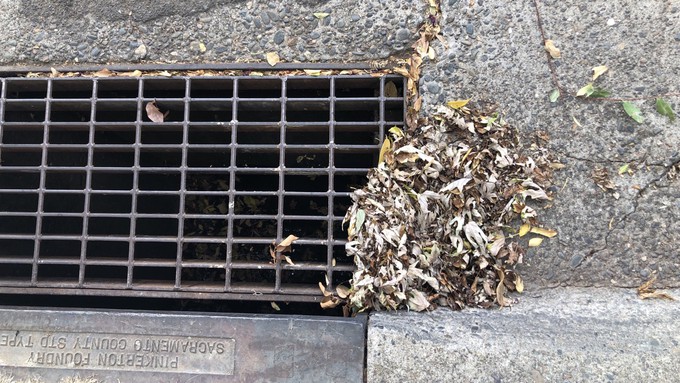
Early storm could soak Sacramento, break long dry spell

Rake leaves out of the gutter to prevent clogs and flooding. Kathy Morrison
Downtown Sacramento’s last measurable rain – 0.15 inches – fell on June 5.
How much could Sacramento get? Forecasters predict ½ to 1 inch between Sunday morning and Tuesday night. That’s significant; Sacramento’s September rain average is 0.29 inches.
Most of this week’s moisture will be steady, soaking showers – good news for trees.
After record highs, temperatures will be unseasonably cool – Monday’s forecast is 69, a 40-degree drop from two weeks ago. After the clouds move on, temperatures will quickly move back into the mid 80s by next weekend.
Move potted plants where they can soak up some of this free water. After the storm, your garden will feel refreshed – and ready to plant for fall.
* After the storm will be a good time to plant for fall. Soil will still be warm and help veggies and fall annuals get off to a fast start.
* Keep harvesting tomatoes, peppers, squash, melons and eggplant.
* Compost annuals and vegetable crops that have finished producing.
* Cultivate and add compost to the soil to replenish its nutrients for fall and winter vegetables and flowers.
* Fertilize deciduous fruit trees.
* Plant onions, lettuce, peas, radishes, turnips, beets, carrots, bok choy, spinach and potatoes directly into the vegetable beds.
* Transplant cabbage, broccoli, kale, Brussels sprouts and cauliflower as well as lettuce seedlings.
* Sow seeds of California poppies, clarkia and African daisies. Transplant cool-weather annuals such as pansies, violas, fairy primroses, calendulas, stocks and snapdragons.
* Divide and replant bulbs, rhizomes and perennials.
* Dig up and divide daylilies as they complete their bloom cycle.
Comments
0 comments have been posted.Sacramento Digs Gardening to your inbox.
Sites We Like
Garden Checklist for week of July 21
Your garden needs you!
* Keep your vegetable garden watered, mulched and weeded. Water before 8 a.m. to reduce the chance of fungal infection and to conserve moisture.
* Feed vegetable plants bone meal, rock phosphate or other fertilizers high in phosphate to stimulate more blooms and fruiting. (But wait until daily high temperatures drop out of the 100s.)
* Don’t let tomatoes wilt or dry out completely. Give tomatoes a deep watering two to three times a week.
* Harvest vegetables promptly to encourage plants to produce more. Squash especially tends to grow rapidly in hot weather. Keep an eye on zucchini.
* Pinch back chrysanthemums for bushy plants and more flowers in September.
* Remove spent flowers from roses, daylilies and other bloomers as they finish flowering.
* Pinch off blooms from basil so the plant will grow more leaves.
* Cut back lavender after flowering to promote a second bloom.
* It's not too late to add a splash of color. Plant petunias, snapdragons, zinnias and marigolds.
* From seed, plant corn, pumpkins, radishes, winter squash and sunflowers.